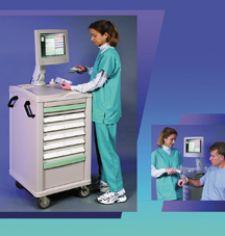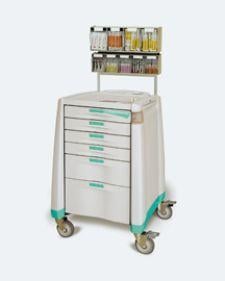
The Avalo AC Anesthesia Cart made by Artromick features integrated drawer dividers and removable drawer tray systems for custom organization. A secondary access requirement such as ID badge card reader or optical bar code scanner and cart user audit can be added.
Without a doubt, the technical specifications and functional options list on your latest anesthesia cart will not compete with the technological specifications of a NASA spacecraft or even your personal computer or laptop. But, even so, it is still very important to the users of these variable tool-chests that they provide a core set of functional options and control features that make them easy to use, safe and secure, and versatile enough to adopt to the rigors of everyday life in the anesthesia world.
Fortunately, the manufacturing arena appears to be astutely aware of the myriad of tough working climates many of these carts are involved in and created a comprehensive assortment of options to make life easier. Although features vary by manufacturer, there are definitely some key factors of a good anesthesia cart purchase recipe that should be considered carefully before deciding on a particular model line or preference package.
Many users will likely be interested in the quality and extent of the security features offered by the manufacturer. Available options range from the extremely simplistic and primarily mechanically driven versions of yester-year, to the extremely advanced locking and security systems that are reminiscent of bank vaults. Some of the newest anesthesia cart security options include sophisticated keypad locking and relocking features to include memory-based systems that can also feed alarming and alert functions as well as electronic medical record systems.
Tamper-proof locking features and auto relock functions can be very useful and necessary for anesthesia related missions. Keyless entry pads and related functional options are available from a variety of manufacturers. These security features can greatly affect the variability in price of units and should be carefully reviewed and compared with other manufacturer options to include the differences assigned between the various model levels offered.
Another key difference in quality and everyday usage is driven by the versatility of the anesthesia cart to be configured appropriately to the individual needs of the daily users. Although most manufacturer options are going to meet the majority of everyday needs in the short-term, the real differences in quality may not show up until these carts have been put into rigorous use. Although this statement may seem trite to some, it is never the less important to look “under the hood” a little closer to get at some of these differences in quality construction and overall versatility when making vendor comparisons.
Seemingly simple aspects, such as the size, quality and construction type of the casters used can have a major impact on how well the anesthesia cart survives being moved around hospital corridors, through tight working environments and over elevator thresholds and similar navigation quagmires. Unfortunately, rough handling conditions coupled with overloaded drawers, can become “reasons” for needing to replace the cart sooner than originally expected when purchased.
This same scenario can be seen in drawer construction and a host of other components. The best defense for preventing these types of purchase problems is to adequately compare these variables before the check is sent to a vendor.
Unit size and configuration options also vary significantly between manufacturers. Even a few inches of width, height or depth can make a huge difference in the ease of use and the long-term satisfaction of an anesthesia cart selection decision. Likewise, the amount of usable writing and/or working service area available on the cart can greatly affect how well the anesthesia cart complements the various working environments. Many operating rooms and radiological sites cannot accommodate all of the equipment needs and/or preferences of the anesthesiologists. To that end, the anesthesia cart used is oftentimes the key workstation and/or working surface available and thus enhances or deters from the quality of the related healthcare delivered at the site.
Another key factor to consider when making comparisons is the variability afforded in being able to reconfigure the cart to different uses. Some manufacturers build in lots of options for changing things around within the drawer options and the methods of storing tools, supplies and meds. Differences include the ability to reconfigure with or without tools and the various options for divvying up the allowable storage space within the cart.
This is not a purchase decision that should be made without the aid of a daily user. Without a doubt, some of the worst purchase decisions associated with anesthesia carts (and many other technologies and supplies) come through programs and processes that allow for the purchase of equipment without proper input and selection from the everyday users. Many of the common purchase mistakes can be easily avoided when purchase decisions are based on qualified user input.
Additionally, many of these quality decisions can also be made better when biomedical engineers and technicians are included in the purchase decision process. Purchase decisions made with the help of all the qualified experts (primarily users and repair personnel) tend to be better over the long term. Anesthesia carts can be purchased cost effectively while simultaneously getting high quality if vendor comparisons are done in accordance with sound principles of review and user involvement.
Top 10 Purchase Aspects
1. Security Features
2. Locking Mechanisms
3. Tamper Resistant Aspects
4. Working Surface
5. Configuration Ability of Drawers
6. Ease of Use and Functionality
7. Quality of Construction
8. Maneuverability
9. Dimensions and Weight
10. Accessories and Components


